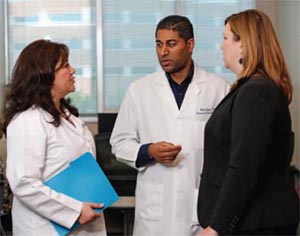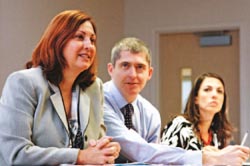Regional expansion extends MD Anderson’s mission to suburbs

It’s 7 a.m. Tuesday, and Loren Rourke, M.D., is on a journey to help breast cancer patients beat the odds.
A breast surgical oncologist, Rourke and her highly skilled team host a multidisciplinary breast cancer conference at
MD Anderson’s Regional Care Center in The Woodlands, a suburb north of Houston.
The Tuesday morning huddle brings together experts in medical oncology, radiation oncology, surgical oncology, plastic surgery, diagnostic imaging, pathology and nursing to review approximately 25 patient cases each week.
The team is involved in every aspect of patients’ care from diagnosis to survivorship. And that’s welcome news for patients and their families.
“Our patients are always so relieved when I tell them their case will be reviewed by our whole health care team,” says Rourke, assistant professor in the Department of Surgical Oncology. “It reassures them to know that we all work together for their benefit.”
Meanwhile, 52 miles south of The Woodlands, John Papadopoulos, M.D., sees his first prostate cancer patient of the day at the regional center in Sugar Land. Nestled in this fast-growing southwest Houston suburb is the center’s new prostate cancer clinic.

John Papadopoulos, M.D., consults with and provides care for
prostate cancer patients at the Sugar Land and Katy centers.
Photo: Austin Miller
“Our patients appreciate that they have easy access to their cancer care team and that we are part of their local medical community,” says Papadopoulos, assistant professor in the Department of Urology and the regional centers’ first urologic oncologist.
To meet the demand for MD Anderson’s standard of prostate cancer care in west Houston, a second prostate cancer clinic has been established at the regional center in Katy.
All the physicians at MD Anderson’s four regional locations around Houston — in the Bay Area, Sugar Land, Katy and The Woodlands — work closely with community referring physicians.
New and familiar territory
MD Anderson’s decision to bring mission-based, high-quality comprehensive cancer care services to the metropolitan Houston area is based on regional population growth and the need to position services conveniently for all patients in the region.
The regional concept was launched in 1999 when the Department of Radiation Oncology brought radiation therapy services to suburban areas outside the Texas Medical Center.
“What started as a single location, ‘satellite’ radiation oncology service has become a clinically integrated, regional system that is bringing TMC campus, disease-specific programs to locations that cover a 10,000-square-mile area,” says surgeon Peter Pisters, M.D., vice president and medical director for the regional care centers.

Hans Sookraj, radiation therapist at the Bay Area center,
explains the use of a treatment immobilization device to
patient Francis Zeringue Jr.
Photo: F. Carter Smith
“We’re regionalizing MD Anderson’s programs and services to bring our world-class brand of comprehensive and patient-centered cancer care to residents across southeast Texas.”
Collaboration across
MD Anderson divisions and departments remains the driving force behind the regional program. While the institution’s care centers all offer medical, radiation and surgical oncology services, some locations also provide specialty services to meet growing demands:
- Accelerated partial breast irradiation
- Intensity-modulated radiation therapy
- Head and neck surgery
- Breast cancer care, including breast surgery
Most recently, dermatology, genitourinary medical oncology and urology services have been added at some of the centers. Gynecologic oncology care is next.
Through that teamwork, new and expanded allied services have emerged at various locations. Among them are pain management, infusion therapy and electronic prescription orders.
The regional centers also work closely with the Division of Pathology and Laboratory Medicine to provide on-site outpatient lab services. Last year, nearly half the patients who accessed regional care services were those receiving care at the TMC campus.
“Having lab work performed near where patients live makes it much more convenient for them,” Pisters says. “Our regional system allows adult and pediatric patients to receive a cancer treatment plan from our TMC campus teams that includes prolonged treatments, like chemotherapy and radiation, which can now be delivered conveniently close to home.”
Holistic care in motion
Each year, the institution also provides more than 600 hours of support services for MD Anderson patients and their caregivers. Consider Traci Newsom, a social work counselor. Each week, she drives to the regional care centers to lend her expertise and ear to patients. She also helps secure hotel and transportation medical discounts, and social services for patients and their families.
“A big part of my job is finding a whole new batch of community resources,” Newsom says. “You have to get out there, meet people and form working relationships first.”

Nikesh Jasani, M.D., medical director (center), visits with
Criselda Polsgrove, nurse manager (left), and Beth Smith,
business services manager, at the Katy center.
Photo: F. Carter Smith
When she’s not on the road, Newsom teaches stress management classes. They’re part of the “Road to Wellness,” a five-step recovery program that helps transition patients to life after treatment.
The program was created in 2007 by Matthew Ballo, M.D., professor in the Department of Radiation Oncology at the Bay Area center.
Social work is part of a growing list of patient support services provided at the centers. Other services include nutritional counseling, physical therapy and lymphedema therapy.
A caravan of support
For many cancer patients and their families, support groups are a critical part of the healing process. Patients often need practical support to help them cope with their new diagnosis or treatment.
MD Anderson provides a wide range of these services in one-on-one and group settings at various regional locations. Senior health education specialists lead classes on how to manage cancer-related fatigue and how to maintain a healthy diet before and after cancer treatment.
Like all support groups sanctioned by the institution, the classes are open to all MD Anderson patients.
At the Bay Area and Sugar Land centers, patients can take part in Look Good ... Feel Better. This program helps them improve their appearance and self-image by arming them with techniques and tools to manage the physical side effects of chemotherapy and radiation treatments.

During a patient treatment planning session in
The Woodlands, radiation oncologists Pamela
Schlembach, M.D. (left), and Michelle Ludwig, M.D.,
are joined by Benjamin Smith, M.D., from
MD Anderson's Texas Medical Center campus.
Photo: John Everett
Once a month at The Woodlands center, Pamela Schlembach, M.D., associate professor in the Department of Radiation Oncology, with the help of Nicole Luckett, breast cancer nurse navigator, facilitates a “Breast Friends” support group. The meeting connects new and former breast cancer patients in the community. A variety of topics are discussed, such as hormone therapy, nutrition, weight loss, advances in oncology, managing symptoms and sexuality.
Within this group, there are small groups for male caregivers, as well as for patients with younger children. To replicate that success, two new “Breast Friends” support groups were formed recently at the Sugar Land and Katy centers.
Access to clinical trials across the region
Research-driven patient care is a hallmark of MD Anderson. Last year, nearly 10,000 patients participated in clinical trials.
An expanded clinical research program means regional patients have access to promising new treatments via hundreds of clinical trials conducted by clinical researchers across the institution. In February, the 100th regional patient enrolled in a clinical trial.
Pisters says the community setting has great clinical research potential and is a haven of hope for many more patients who would otherwise miss out on potentially life-saving treatment.
“MD Anderson’s research mission spans a wide geographic area that will reach 7 million residents by 2020,” he says. “Through this expansion, we’re bringing cutting-edge clinical trials to more patients closer to where they live and work.”
For more information about MD Anderson’s regional care system, check the website.
Regional care center fast facts
- Four suburban locations are in Katy, Sugar Land, The Woodlands and the Bay Area.
- Patients receiving care increased by 200% from 2009 to 2011.
- In Fiscal Year 2011, MD Anderson regional care centers saw 6,423 patients.
- The growing regional workforce includes nearly 250 full-time employees, including 25 physicians, 55 nurses and mid-level providers and 40 access
team members. - During FY11, 26 regional care center volunteers contributed 2,904 hours.













